NEW YORK—When it comes to recycling facilities, most don’t associate it with the term ‘state of the art.’ But the newly opened Sunset Park Material Facility looks like a modern art gallery from afar: clean lines, white walls, and a simple structure. On a sunny day, it stands out starkly among the grey industrial buildings lining the Brooklyn waterfront.
The $110 million facility WAS designed by Selldorf Architects and is made entirely out of 99 percent recycled American-made steel. It embodies the solutions for problems facing city dwellers today, such as climate change, waste management, pollution, and limited energy resources.
A blend of recycled glass and crushed stone from the Second Avenue subway tunneling operations makes up the foundation that elevates the structure 4 feet off the ground. This foundation cost an extra million dollars but prevented the equipment and buildings from being destroyed by Hurricane Sandy. The facility was still under construction at the time and it was one of the few structures left standing near the waterfront after the disaster.
The creation of Sunset Park Material Recovery Facility is an important part of Mayor Bloomberg’s PlaNYC 2030 to develop sustainable waste management in New York City. The facility processes up to 1,000 tons of material each day and has the capacity to process all 19,000 tons of metal, glass, and plastic collected monthly by the Department of Sanitation.
The majority of the inbound material will arrive by barge instead of by truck. The creation of the facility will stop Department of Sanitation trucks from having to travel 240,000 miles per year, thus reducing congestion, fuel consumption, and vehicle emissions.
The city and Sims Metal Management funded the facility. As part of a long-term contract between the Department of Sanitation and Sims Municipal Recycling, it will be the main facility to process all of New York City’s curbside metal, glass, and plastic recyclables. It will also take approximately 50 percent of the city’s curbside paper recyclables.
“This enables us to make the single largest expansion of the recycling program in 25 years,” said Deputy Mayor of Operations Cas Holloway at the official opening of the facility.
It took 10 years for the facility to come to fruition: 7 years of planning and 3 years of construction. The site had previously been a NYPD impoundment lot and residents weren’t sure if they wanted a processing facility in their back yard.
“When I saw it 7 years ago, I kind of walked through it and said, ‘Well, this isn’t going to happen. We’re going back to Jersey,” said Bob Kelman, president of the Sims North America Metals business unit.
Sims reached out to community board members and Council member Sara Gonzalez of District 38, and was able to get them on board with the project, which is expected to create approximately 75 full time jobs for local residents.
“To understand that we’re going to downplay all these trucks, that we’re going to do so much to ensure that our environment is safe and good for the future, that’s what’s important to me,” said Gonzalez.
One issue the facility may face is economic sustainability. Mayor Bloomberg approached Kelman on multiple occasions and advised that a recycling business must be consistent and profitable.
“He’s exactly correct,” said Kelman. “In order for recycling to be long term in the city, it must be an economically viable proposition, because if it isn’t and it’s otherwise subsidized, we all know it won’t work.”
Will the facility be able to sustain itself in the long run? That depends on how much New Yorkers are willing to recycle. A higher volume of recyclables means more income for the facility.
“As New Yorkers and people that want to have a greener environment, a better environment in the city, we have to learn to do more of it each and every day,” said Sanitation Commissioner John Doherty.
Yi Yang is a special correspondent in New York.




